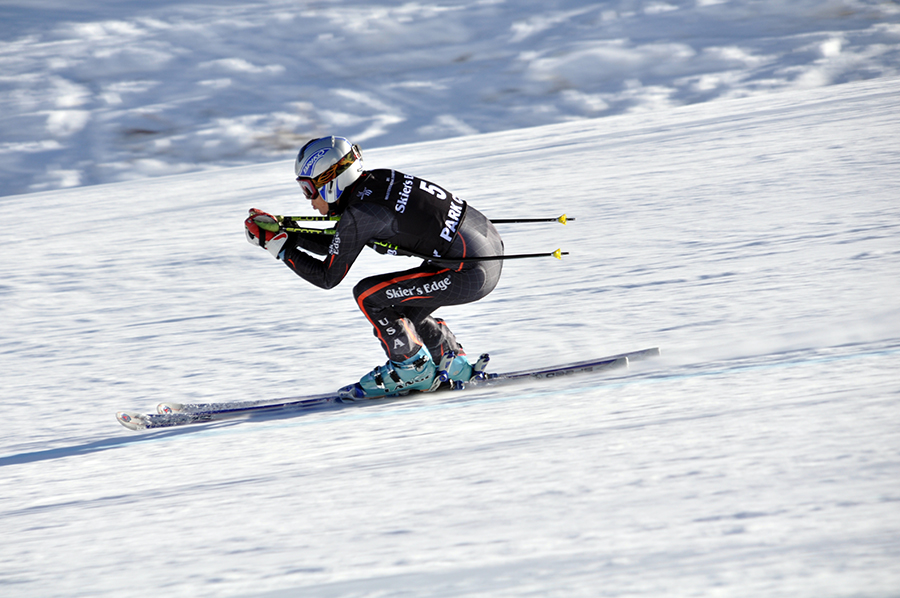What’s the Right Ski for Masters Racing?
A peek at what top athletes across the age groups are using for lengths and sidecuts.
Race stock skis — so done.
For years, masters racers coveted those purportedly super-special, super-fast, hand-made, hand-selected skis reserved for the top racers in the world. But now that FIS rules require longer, straighter skis for World Cuppers and other elite-level athletes, race stock boards have lost their caché.
Technically, masters racers can use whatever skis they want. “USSA recommends that competitors in USSA masters races compete on equipment designed for the particular discipline (DH, SG, GS, SL),” state the rules, “but does not make any recommendations in regards to ski length, radius or profile width.”
That leaves many of us scratching our heads.
At first, masters racers eked out a couple more seasons on whatever shorter, tighter-radius skis they had. But now, a few winters later, those old skis are showing their age, and many of us are looking for new, “real” race skis — not the detuned NASTAR/beer league models, but with tighter sidecuts than those used by Ted Ligety and Lindsey Vonn.
Manufacturers have answered the demand and are now selling a myriad of new race skis with “old” sidecuts, meaning a tighter radii. Picking the right one can greatly influence your performance on the hill and the thickness of your wallet, so it’s not a decision made lightly.
This guide should help you pick the fastest ski out there for masters racing.
Ski Length
The correct ski for you is based on your size, fitness level and ability level. The more you weigh, the stronger you are, and the faster you rip, the longer your ski. Shorten up a little if you are lightweight, if you’re not as fit as you should be or if you are cautious in certain places on a course. For example, if you’re a male masters racer, you work out daily and look for speed every moment of a run but weigh only 150 pounds, a shorter GS ski, around 185 centimeters, is a smarter choice than a 195 cm FIS-length GS ski.
A standard women’s FIS GS ski is 188 cm long. As another example, if you’re a female masters racer who weighs 150 pounds, rips down the course, but keeps missing your CrossFit class, you’ll like a 180 cm GS ski much better than a 188. Both men and women should adjust the length of ski downward another 5 cm if two or more of the criteria — weight, strength, skill — are not honed to a high-performance level.
Sidecut
Tight, 18-meter sidecut GS skis may be the rage, but perhaps not the fastest choice for everyone. The higher the edge angle you create while turning, the bigger the sidecut you can handle. If you get a lot of angulation, you can actually have too much sidecut, which makes the skis feel hooky. While most masters racer prefer a GS radius under 25 m, an 18 m ski may be too tight for you, depending on your line and the amount of edge angle you can create.
Terrain matters, too. If most of your races are on flat terrain, skis with a tighter sidecut tends to turn more cleanly.
There’s one more consideration among masters racers, age. The older the racer, the shorter the length and tighter the radius their skis tend to be.
Here’s a look what the top masters racers in the U.S. are skiing on for slalom, GS and super G, to help you make your decisions.
Slalom
For women, there’s only one choice among adult race skis regarding length: 155 cm (plus or minus 2 cm). Sidecuts are in a very small range, 11 m to 12 m. If you weigh 120 pounds or more, pick a slalom ski with these measurements. If you’re smaller than that, consider a junior ski, which is likely your only choice among smaller slalom skis.
Masters-level men have more options, ranging from a women’s-length 155 cm ski to a World Cup-length 165 cm ski with a radius from 12 m to 13 m. Among the masters national team members, those under age 50 use 165 cm skis. Those aged 50-plus tend to go shorter. (See chart below.)
GS
The top masters women under age 55 use GS skis around 180 cm. Older gals go shorter, 175 cm then to 170 cm as age increases. The radii are tight, primarily under 20 m for all but a handful of the younger racers.
With the exception of the very oldest age groups, the length of ski for top-level masters men correlates more to their size and ability rather than their age. The longest skis are about 190 cm. The shortest are about 175 cm. The average is 185 cm long with a 25 m radius.
Super G
Only two members of the masters national team, Pepi Neubauer and Phillips Armstrong, are on FIS-radius (40 m) super G skis. Everyone else is on an older, more forgiving sidecut (equal to or greater than 33m or tighter). Most of the men are on a 200 cm to 205 cm super G ski. The women are on 201s or shorter.
Race skis aren’t cheap, so they shouldn’t be a crapshoot. If you use these lengths and sidecuts as a reference and pick a ski with an even, forgiving flex, you’ll be happy not only in a course but also racing for a gold medal.
Ski selection tips from members of the 2016 U.S. Alpine Masters Team
Curious what the sidecut of a pair of skis really is?
Check out this Ski Radius Calculator developed by the FIS
2016 U.S. Alpine Masters Ski Team — Ski Lengths and Radii (download here)
Most men under age 50 on the masters circuit opt for a 165 cm slalom ski.

Photo courtesy of Ara Papazian
Pepi Neubauer skis on a 26.5 m radius GS ski, much tighter than a men’s World Cup ski (35 m), but not as tight as the latest “cheater” GS skis.
Women have only one choice when it comes to adult-length slalom skis — 155 cm (plus or minus 2 cm).

Photo courtesy Louise McKee
Pierre Jeangirard skis fast on a 180 cm, 20 m radius GS ski, the shortest ski and tightest radius used by any man on the 2016 U.S. Alpine Masters ski team.

Photo courtesy of Pierre Jeangirard
Anna Droege frequently beats women 10 years younger on 185 cm super G skis with a 27 m radius. Most of the top women on the masters circuit, age 65 and older, race super G on skis with similar dimensions.



































